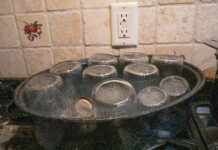No matter where you live, work or play, clean water is a critical resource. For more than 75 years, soil and water conservation districts have been leaders in locally-led efforts to ensure a clean and sustainable water supply for the nation. With earned trust and a proven ability to form partnerships at the local level, such as the one we have with Rotary, conservation districts are well-positioned to play a key role in addressing water-quality challenges in local communities and to find solutions to those challenges by working with other stakeholders.
According to the National Water Quality Inventory, 70% of lakes, reservoirs and ponds, 78% of bays and estuaries and 55% of rivers and streams assessed in the U.S. are impaired by pollution and do not meet minimum water quality standards. The leading causes of river and stream impairments are pathogens, sediments and nutrients. Often, the probable cause of impairment is unknown.
Gov. Mike DeWine’s H2Ohio program, launched in 2019, uses a comprehensive approach guided by science and data to reduce algal blooms, stop pollution and improve access to clean drinking water by supporting best farming practices, road-salt runoff reduction, litter cleanup, dam removal, land conservation and water infrastructure revitalization.
Why it matters
You may being asking yourself, why should we care so much about clean water, sanitation and hygiene? And what can we do? Well, repairing water quality can be quite costly. Here in Mahoning County, the majority of our potable water supply comes from surface bodies of water. So, it’s important for us to take preventative steps to protect our water supply so that treatment costs for potable (drinkable) water is kept to a minimum.
We also enjoy recreational activities in our local bodies of water. We have beautiful parks and green spaces where adults and children swim, fish and boat — another important reason to protect our water quality.
I was recently reading an article from our friends at Re-Leaf, and they said it best:
“Environmental sanitation refers to a comprehensive set of practices and measures aimed at maintaining and promoting public health through the proper management of waste, hygiene and the surrounding environment. The goal of environmental sanitation is to prevent the spread of diseases, protect ecosystems and create a healthier living environment for communities by addressing issues related to pollution, inadequate sanitation and improper waste management. Environmental sanitation is of paramount importance for several key reasons. It plays a critical role in preventing the spread of diseases, ultimately safeguarding public health. Effective environmental sanitation helps preserve ecosystems and biodiversity by minimizing pollution and contamination of water bodies, soil, and air. This contributes to the overall ecological balance and supports sustainable development. It enhances the quality of life for individuals and communities, creating more livable and aesthetically pleasing surroundings. Lastly, by addressing environmental sanitation, we can mitigate the impact of climate change, as well-maintained ecosystems are better equipped to absorb shocks and provide climate resilience.”
Education is key
Above everything, we must educate our community. We can never enact positive change unless we educate people as to why change is necessary.
An important part of what soil and water districts do is to educate the public, both young and old, as to water quality concerns and how each person can be a part of the solution to those water quality concerns and issues. We do a lot of this through a program called Project Wet which focuses on water quality water sanitation and hygiene.
We often take it for granted. We turn on the tap, and it’s there. We flush the toilet, and it’s gone. Water sustains us in ways we often overlook. Yet, so many of us don’t even know where the water in our home comes from. Water education encourages understanding of this precious resource and equips students with knowledge about the water-related challenges our world does and will face.
Here are five reasons why we need water education: 1. Water is a vital resource. 2. Water education leads to overall environmental stewardship. 3. Knowing where your water comes from increases appreciation of the resource. 4. Grasping the concept of drought and water scarcity is crucial. 5. Creating opportunities for future careers in the water industry is essential.
Water education is crucial for our future. It leads to environmental stewardship and can create opportunities for future careers in the water industry. We must create a world where water education empowers every person to protect and conserve our planet’s water resources
Clean water, sanitation and hygiene is more than just a matter of aesthetics; it is a critical component of public health, quality of life, and long-term development. A clean and well-maintained environment contributes to the physical and psychological well-being of individuals while fostering a sense of community pride and responsibility.
We must improve environmental sanitation in the community, which will result in a cleaner, healthier and more sustainable living environment for people today and future generations. Call your local soil and water office to see how you can learn more about clean water and volunteer to be a part of the solution.













